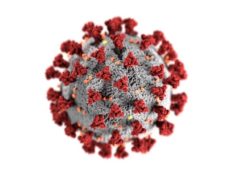
Describing the Northwell CORE-19 registry as “the largest prospective registry of thromboembolic complications in hospitalised COVID-19 patients in the post-hospital discharge period,” lead investigator Alex Spyropoulos (Northwell Health and Donald and Barbara Zucker School of Medicine at Hofstra/Northwell, New York, USA) speaks to Venous News about early findings of the study, recently presented to the American Society of Haematology (ASH) as an oral abstract. Spyropoulos details how these provide “high-quality data” in a growing field, and highlights what future research in this fast-growing field might look like.
What are the aims of the Northwell CORE-19 registry?
This is the largest prospective registry of thrombotic complications in hospitalised-COVID-19 patients in the post hospital discharge period. To begin with, we focused on the 90-day post-discharge period and post-hospital discharge thromboembolic complications, as well as other key clinical outcomes. As far as I am aware, this represents the largest global dataset in this timeframe for this population.
How have the data been collected?
The data for this early phase of the registry was collected completely prospectively, using telephone follow-up, and I think that represents a major strength of the data quality. Whereas previous efforts were completely retrospective in nature—using things like claims and other databases—we collected the data prospectively within the 90-day timeframe after patients left the hospital.
It is also important to note that with these data we were able to use a unified mark—or data repository—and a common data model, so we used a combination of not just the telephone calls and electronic health records, but also information from both health informatics exchange and manually adjudicated radiology reports. Overall, this represented a complete database from an outcome perspective.
What are the findings of the registry so far?
So far, the CORE-19 registry has showed that the immediate post-hospital discharge period is not a benign period with respect to thromboembolic events. We found a venous thromboembolic event rate of 1.55%, which constituted deep vein thrombotic events and pulmonary embolism, roughly split 50/50.
In addition, we found an elevated rate of arterial thromboembolism of 1.7% or so, including stroke, myocardial infarction (MI), and non-MI or coronary revascularisation, as well as major adverse limb events and systemic embolic events, roughly split equally among those four key criteria.
Other key outcomes included an all-cause mortality rate of 4.8%, a rehospitalisation rate of 15% within 90 days—of which roughly one-third constituted admission to the intensive care unit—and a major bleeding rate of about 1.7%.
Lastly, some of the other key findings were an approximate 1.3% rate of heart failure exacerbation and 0.45% rate of atrial fibrillation flutter, a 0.5% rate of interstitial lung disease, and an acute respiratory distress syndrome rate of about 2.3%.
What is the overall significance of these results?
In patients with acute infections, we saw an approximately two-fold or even higher increase in incidence of venous thromboembolism and other thrombotic complications in the post-discharge period compared to databases in the pre-COVID-19 era. These data strongly suggest that a strategy of post-discharge thromboprophylaxis should be considered, at least in a subset of high-risk hospitalised COVID-19 patients.
Of course, further analysis for this database is warranted, including multivariable analysis of risk factors associated with thrombosis and all-cause mortality, and identification of high-risk patients that may benefit from a strategy of post-discharge thromboprophylaxis.
When can we expect further results from this registry?
We have to do further statistical analysis, especially in key subgroups, and also compare post-discharge events with rates of post-discharge thromboprophylaxis. We hope to get the data out in publishable form quite soon, in the next few months or so. I think this is very important data that will likely influence future guidelines on the topic.
How does this study fit into the wider and growing pool of data regarding venous disease and COVID-19?
We know from multiple reports, starting in China, then Europe, and now the USA, that thrombotic complications represent a key feature in hospitalised COVID-19 patients. What we saw with the previous data was that the hospital period represented a high-risk period for thrombotic events, the majority of which constituted venous thromboembolic events. Now, we see from this CORE-19 registry database that the immediate post-hospital discharge period also represents a relatively high-risk period with respect to thromboembolic events in hospitalised COVID-19 patients, and these events are roughly split equally between venous and arterial thromboembolic events.
I think what is important is continuing to collect high-quality data in this vastly growing field, including data from high-quality randomised controlled trials, in order to inform best practice. I believe databases such as the CORE-19 registry and the CORONA registry that was done at Harvard, as well as ongoing randomised trials, give us high-quality answers to the many pressing clinical questions in this population.
These things take a long, long time, but hopefully the data quality makes this all worth it. That is the key—we have data, but the key now is to tap into the realm of high-quality data.








